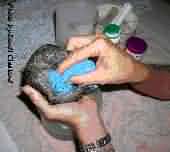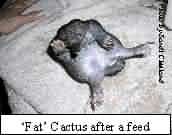RECORD KEEPING:
 Records will have to be kept to ensure a proper weight gain. Write in the weight before and
after each feed.
Records will have to be kept to ensure a proper weight gain. Write in the weight before and
after each feed.
CLEANING:
After each feed clean the puggle with a soft cloth and tepid water. Ensure all milk residue is
cleaned from around the snout and the rest of the body where milk may accumulate. They often
get their little feet in the milk and into crevices between skin folds. Also clean dirt from
the body before applying the Calendula cream.
CLEANING UTENSILS:
The feeding tube will be hard to clean unless it is inserted directly into soapy, boiling
water immediately after the feeding, to prevent the milk formula from sticking to the inside
of the tubing. Continually flush the tube with hot, soapy water before rinsing through with water.
Bash the tube against a hard object to clear all water out of it before hanging it to fully dry.
Keep it in an air tight container once dry, in a dark cupboard. The major factor is to keep the
feeding utensils DRY. Less bacteria will survive in dry conditions.
TOILETING
There is no need to toilet the puggle, it will pass urine or faeces when the urge dictates.
As a result of such a slow digestion, an echidna does not defecate or urinate after a meal.
In fact the animal may go for days without going to the loo! We observed one of our puggles
defecating whilst it was in the bathtub of dirt, and it covered the waste with dirt, just
like a cat! So it would be difficult indeed to expect it to go on demand, and it’s no wonder
we don’t get to see echidna droppings in the wild. Another puggle would sometimes pass a soft
pellet or urinate at feed time.
LUBRICATION:
Calendula cream is excellent for keeping the puggle’s skin from drying and can also be used as
a healing agent. Alternately Ungvita may be used.
WHEN TO FEED:
 A spineless puggle should be fed (with a five gauge feeding tube) initially every 2 days,
(48 hours). If the puggle is just spined it will require tube feeding every 3 days, (72 hours)
so the cost of using a new sterile feeding tube is minimal, but if these are difficult to purchase,
(your vet should be able to order them for you) they can be boiled for at least 11 minutes prior
to feeding.
A spineless puggle should be fed (with a five gauge feeding tube) initially every 2 days,
(48 hours). If the puggle is just spined it will require tube feeding every 3 days, (72 hours)
so the cost of using a new sterile feeding tube is minimal, but if these are difficult to purchase,
(your vet should be able to order them for you) they can be boiled for at least 11 minutes prior
to feeding.
If the puggle is contented it will sleep peacefully without moving around between the feeds.
If it is not contented it may squeak often, move around, or lie on its side, these actions may
indicate hunger, or another underlying problem. By observing the animal you should be able to
tell when to increase the time between feeds to 3 day intervals, then 4 etc.So it is up to the
carer to observe the puggle, to determine whether it needs feeding either every 2 or 3 days,
but it will not be able to digest the formula if it is fed more often than 2 day intervals!
The result will be death.
By using the graph in this section you can see that the deciding factor of how often to feed
is simply by the amount of weight the animal has used in energy between feeds. When the puggle
uses
less energy between the feed times , this indicates that longer intervals between feeds can
be undertaken.
When the puggle uses less energy between feeds this will indicate that the feed intervals can be
stretched to another day between feeds.
The weight before a feed should never be less than the weight at the weigh-in prior to the
previous feed. (If that is confusing, check the graph in this section)
WHEN TO CHANGE TO THE >30 MILK FORMULA:
Once the puggle’s eyes are both fully opened and it has developed spines all over its body the
<30 and the >30 can be mixed together at a ratio of 3/4 of <30 to 1/4 >30 for 1 feed, then 1/2
of <30 to 1/2 >30 for 1 feed, then 1/4 <30 to 3/4 >30 for the last feed before going over to
full >30 strength. Considering the puggle would be fed every fourth day by this stage, this
transition will take 16 days to change over.The second formula >•30 mirrors the requirements for
a spined puggle, with much more fat available, to ensure that the animal builds up condition in
readiness for living outside and enduring cold weather. If an echidna does not receive this
high fat nutrition from its diet, it will fail to survive once outside and enduring the climatic
conditions.
Copyright © 2003 Lynda Staker -
Taken from Lynda Staker's book " Don't Step Backwards "
Back to Echidna index
Back to FRW Home page
 Records will have to be kept to ensure a proper weight gain. Write in the weight before and
after each feed.
Records will have to be kept to ensure a proper weight gain. Write in the weight before and
after each feed. A spineless puggle should be fed (with a five gauge feeding tube) initially every 2 days,
(48 hours). If the puggle is just spined it will require tube feeding every 3 days, (72 hours)
so the cost of using a new sterile feeding tube is minimal, but if these are difficult to purchase,
(your vet should be able to order them for you) they can be boiled for at least 11 minutes prior
to feeding.
A spineless puggle should be fed (with a five gauge feeding tube) initially every 2 days,
(48 hours). If the puggle is just spined it will require tube feeding every 3 days, (72 hours)
so the cost of using a new sterile feeding tube is minimal, but if these are difficult to purchase,
(your vet should be able to order them for you) they can be boiled for at least 11 minutes prior
to feeding.